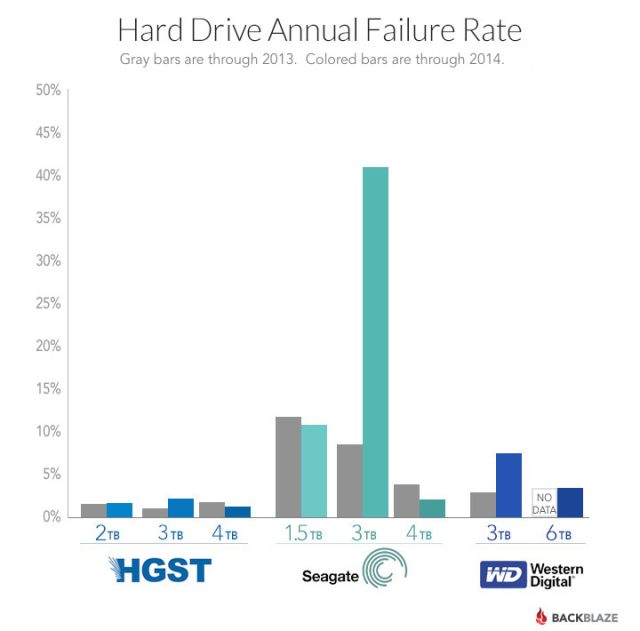
A year ago we got some insight into hard disk reliability when cloud backup provider Backblaze published its findings for the tens of thousands of disks that it operated. Backblaze uses regular consumer-grade disks in its storage because of the cheaper cost and good-enough reliability, but it also discovered that some kinds of disks fared extremely poorly when used 24/7.
A year later the company has collected even more data and drawn out even more differences between the different disks it uses.
For a second year, the standout reliability leader was HGST. Now a wholly owned subsidiary of Western Digital, HGST inherited the technology and designs from Hitachi (which itself bought IBM's hard disk division). Across a range of models from 2 to 4 terabytes, the HGST models showed low failure rates; at worse, 2.3 percent failing a year. This includes some of the oldest disks among Backblaze's collection; 2TB Desktop 7K2000 models are on average 3.9 years old, but still have a failure rate of just 1.1 percent.
At the opposite end of the spectrum are Seagate disks. Last year, the two 1.5TB Seagate models used by Backblaze had failure rates of 25.4 percent (for the Barracuda 7200.11) and 9.9 percent (for the Barracuda LP). Those units fared a little better this time around, with failure rates of 23.8 and 9.6 percent, even though they were the oldest disks in the test (average ages of 4.7 and 4.9 years, respectively). However, their poor performance was eclipsed by the 3TB Barracuda 7200.14 units, which had a whopping 43.1 percent failure rate, in spite of an average age of just 2.2 years.
Backblaze's storage is largely split between Seagate and HGST disks. HGST's parent company, Western Digital, is almost absent, not because its disks are bad, but because they came out as consistently more expensive than those from Seagate and HGST.

Newer Seagate disks also show more encouraging results. Although still young, at an average age of just 0.9 years, the 4TB HDD.15 models show a reasonably low 2.6 percent failure rate. Coupled with their low price—Backblaze says that they tend to undercut HGST's disks—they've become the company's preferred hard drive model.
As before, this doesn't mean that anyone with a Seagate disk is at risk of an imminent hard disk failure (though you should always have backups!). Backblaze operates disks outside of the manufacturer's specified parameters. Significantly, most consumer-grade disks aren't intended to be heavily used 24/7; they're meant to be operational for about 8 hours a day and replaced every 3 to 5 years. Most home usage environments are likely to be lower in vibration than Backblaze's 45-disk storage pods, too. In more normal conditions, the Seagates are likely to fare much better.
reader comments
159